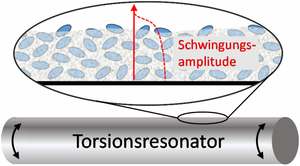Biofilm monitoring
NTH Research Group: ElektroBak - Innovative materials and concepts for microbial electrochemical systems (Subproject B3 - Biofilm monitoring)
The thickness of an electrochemically active biofilm, its cell density, stability and transport properties, the kinetics of its formation and its robustness to variable environmental conditions are of central importance for the efficiency and practical use of bioelectrochemical cells. The aim of this subproject is to develop a method for in situ determination of the thickness and shear stiffness of electrically active biofilms using acoustic torsional resonators.i The acoustic properties will be correlated with the electrochemical properties to develop a physical-electrochemical biofilm model.
Central questions are:
- To what extent does current yield correlate with film thickness? Is there an optimal film thickness?
- Can acoustic data be fed into a control system that optimizes the environmental conditions with regard not only to current efficiency but also to the longevity of the cell?
- Can the viscoelastic properties of the film be used to infer its transport properties (nutrient, protons)?
A torsional resonator consists of a cylindrically shaped piezo crystal that is excited into torsional oscillation via electrodes. The resonance frequency is in the range of 50 kHz. The resonance frequency and resonance width change on contact with a sample. These changes are converted into a film thickness and an apparent stiffness of the film in a viscoelastic model. The dashed line above outlines the amplitude distribution of the shear wave.
Further links
Link to the ElektroBak project website.
Link to sub-project B3 on the ElektroBak project website.
- P. Sievers, C. Moß, U. Schröder, and D. Johannsmann
Use of torsional resonators to monitor electroactive biofilms
Biosensors and Bioelectronics, 110 225 (2018). - W. Bücking, B. Du, A. Turshatov, A. M. Konig, I. Reviakine, B. Bode, and D. Johannsmann
Quartz crystal microbalance based on torsional piezoelectric resonators
Review of Scientific Instruments, 78 074903 (2007).
